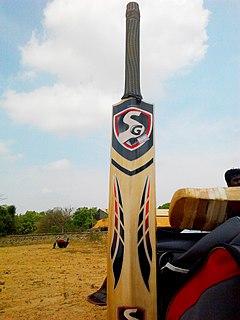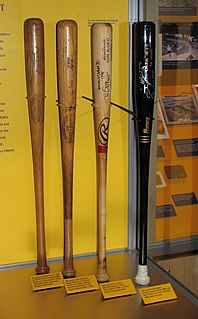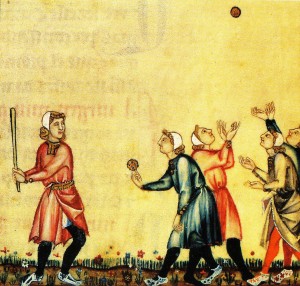Knurr and spell (also called northern spell, [1] nipsy or trap ball) is an old English game, once popular as a pub game.
Contents

Knurr and spell (also called northern spell, [1] nipsy or trap ball) is an old English game, once popular as a pub game.

The game originated in the moors of Yorkshire, in England, but then spread throughout the north of England. [2] It can be traced back to the beginning of the 14th century.[ citation needed ] It was especially popular in the 18th and 19th centuries, but was virtually unknown by the 21st century, [3] though there was a local revival in the 1970s. [4] As late as the 1930s exhibition games of knur and spell by veterans drew large crowds to the Rusland Valley in North Lancashire, according to the chronicles of the North-West Evening Mail , but even then it was regarded as an archaic game.
Knurr (from Middle English: knurre, knot) refers to a hardwood or pottery [4] ball, as could be made from a knot of wood. Spell (from Danish : spil, spindle) is the stick of wood used to strike it. [5]
In Yorkshire it is played with a levered wooden trap known as a spell, by means of which the knurr, about the size of a walnut, is thrown into the air. In Lancashire the knurr is suspended stationary from string. The knurr is struck by the player with the stick. The object of the game is to hit the knurr the greatest possible distance, either in one or several hits. [5] Each player competes as an individual, without interference, and any number can enter a competition. [2]
The stick is a bat consisting of two parts: a 4 feet (1.2 m) long stick made of ash or lancewood;[ citation needed ] and a pommel, a piece of very hard wood about 6 inches (150 mm) long, 4 inches (100 mm) wide and 1 inch (25 mm) thick. This was swung in both hands, although shorter bats for one hand were sometimes used. [2] [5] A successful hit drives the ball about 200 yards (180 m). The stroke is made by a full swing round the head, not unlike a drive in golf. [2]
Originally the ball was thrown into the air by striking a lever upon which it rested in the spell or trap, but in the later development of the game a spell or trap furnished with a spring was introduced, thus ensuring regularity in the height to which the knurr is tossed, somewhat after the manner of the shooter's clay pigeon. By means of a thumb screw, the player can adjust the spring of the spell or trap according to the velocity of release desired for the ball. [2] [5]
On a large moor, and where the game is general, the ground is marked out with wooden pins driven in every 20 yards (18 m). In matches each player supplies their own knurrs and spells and has five rises of the ball to a game. [2]

Rounders is a bat-and-ball game played between two teams. Rounders is a striking and fielding team game that involves hitting a small, hard, leather-cased ball with a rounded end wooden, plastic or metal bat. The players score by running around the four bases on the field.

Softball is a game similar to baseball played with a larger ball on a field that has base lengths of 60 feet, a pitcher's mound that ranges from 43-50 feet away from home plate, and a home run fence that is 220-300 feet away from home plate, depending on the type of softball being played. It was invented in 1887 in Chicago, Illinois, United States as an indoor game. The game moves at a faster pace than traditional baseball. There is less time for the base runner to get to first while the opponent fields the ball; yet, the fielder has less time to field the ball while the opponent is running down to first base. The name "softball" was given to the game in 1926, because the ball used to be soft; however, in modern-day usage, the balls are hard.

Skittles is an old lawn game and target sport of European origin, from which the modern sport of bowling is descended. In regions of the United Kingdom and Ireland the game remains a popular indoor pub game. A continental version is popular in Germany, Austria and Switzerland. Other varieties of bowling are more popular in Australia, but the similar game of kegel, based on German nine-pin bowling, is popular in some areas. In Catalonia, bitlles, a local version of this game, was formerly popular.
The Laws of Cricket is a code which specifies the rules of the game of cricket worldwide. The earliest known code was drafted in 1744 and, since 1788, it has been owned and maintained by its custodian, the Marylebone Cricket Club (MCC) in London. There are currently 42 Laws which outline all aspects of how the game is to be played. MCC has re-coded the Laws six times, the seventh and latest code being released in October 2017. The 2nd edition of the 2017 Code came into force on 1 April 2019. The first six codes prior to 2017 were all subject to interim revisions and so exist in more than one version.

A cricket bat is a specialised piece of equipment used by batsmen in the sport of cricket to hit the ball, typically consisting of a cane handle attached to a flat-fronted willow-wood blade. The length of the bat may be no more than 38 inches (965 mm) and the width no more than 4.25 inches (108 mm). Its use is first mentioned in 1624. Since 1979, a law change stipulated that bats can only be made from wood.
The question of the origins of baseball has been the subject of debate and controversy for more than a century. Baseball and the other modern bat, ball, and running games—cricket and rounders—were developed from folk games in early Britain, Ireland, and Continental Europe. Early forms of baseball had a number of names, including "base ball", "goal ball", "round ball", "fetch-catch", "stool ball", and, simply, "base". In at least one version of the game, teams pitched to themselves, runners went around the bases in the opposite direction of today's game, and players could be put out by being hit with the ball. Just as now, in some versions a batter was called out after three strikes.

A baseball bat is a smooth wooden or metal club used in the sport of baseball to hit the ball after it is thrown by the pitcher. By regulation it may be no more than 2.75 inches (7.0 cm) in diameter at the thickest part and no more than 42 inches (1.067 m) in length. Although historically bats approaching 3 pounds (1.4 kg) were swung, today bats of 33 ounces (0.94 kg) are common, topping out at 34 ounces (0.96 kg) to 36 ounces (1.0 kg).

Bat and trap is an English bat-and-ball pub game. It is still played in Kent, and occasionally in Brighton. By the late 20th century it was usually only played on Good Friday in Brighton, on the park called The Level, which has an adjacent pub called The Bat and Ball, whose sign depicts the game. Brighton & Hove City Council started a Bat and Trap club based at The Level in 2013, as part of the Activities Plan associated with a £2.2m Heritage Lottery Fund and Big Lottery Fund-funded restoration of the park.

Aunt Sally is a traditional English game usually played in pub gardens and fairgrounds, in which players throw sticks or battens at a model of an old woman's head. Leagues of pub teams still play the game today, throughout the spring and summer months, mainly in Oxfordshire and some bordering counties.
Yorkshire County Cricket Club in 2005 were in the second division of both the County Championship and the totesport League. At 6–1 odds to win the Second Division of the County Championship, they were likely to struggle again – as they had done since they won the First Division championship in 2001.

Lacrosse has its origins in a tribal game played by eastern Woodlands Native Americans and by some Plains Indians tribes in what is now the United States of America and Canada. The game was extensively modified by European colonizers to North America to create its current collegiate and professional form. There were hundreds of native men playing a ball game with sticks. The game began with the ball being tossed into the air and the two sides rushing to catch it. Because of the large number of players involved, these games generally tended to involve a huge mob of players swarming the ball and slowly moving across the field. Passing the ball was thought of as a trick, and it was seen as cowardly to dodge an opponent. Years later lacrosse is still a popular sport played all over the world.

Higham is a village in the metropolitan borough of Barnsley in South Yorkshire, England. The village falls within the Dodworth ward of the Barnsley MBC.

A pub game is one which is traditionally played in or outside a pub or bar. Most pub games date back many years and are rooted in village culture. Many derive from older outdoor sports.

Tip-cat is a pastime which consists of tapping a short billet of wood with a larger stick ; the shorter piece is tapered or sharpened on both ends so that it can be "tipped up" into the air when struck by the larger, at which point the player attempts to swing or hit it a distance with the larger stick while it is still in the air.

Dartball is a game in which darts are thrown at a large wooden or homasote board that resembles a baseball field with colored areas which denote bases. Dartball uses baseball-like rules and scoring.
Barry Wood is an English former cricketer, who played twelve Tests for England as an opening batsman, as well as thirteen One Day Internationals. He played first-class cricket for Yorkshire in 1964, for Lancashire from 1966 to 1979, and for Derbyshire from 1980 to 1983, where he was captain for three seasons.

Bat-and-ball games are field games played by two opposing teams, in which the action starts when the defending team throws a ball at a dedicated player of the attacking team, who tries to hit it with a bat. The best known modern bat-and-ball games are baseball and cricket, with common roots in the 18th-century games played in England.
The Roses Match refers to any game of cricket played between Yorkshire County Cricket Club and Lancashire County Cricket Club. Yorkshire's emblem is the white rose, while Lancashire's is the red rose. The associations go back to the Wars of the Roses in the 15th century. These matches have a long and proud history and are traditionally the hardest fought matches in the English first class game, with many dour draws recorded as both teams battled to avoid the ignominy of defeat.

Indigenous North American stickball is considered to be one of the oldest team sports in North America. Stickball and lacrosse are similar to one another, the game of lacrosse is a tradition belonging to tribes of the Northern United States and Canada; stickball, on the other hand, continues in Oklahoma and parts of the Southeastern U.S. where the game originated. Although the first recorded writing on the topic of stickball was not until the mid-17th century, there is evidence that the game had been developed and played hundreds of years before that.